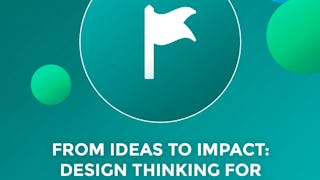Human-centered design is an approach that focuses on human needs, goals, and experiences to frame problems, develop solutions, and coordinate resources. Through a series of videos, activities, and reflection, learners will develop an appreciation for the value and impact of human-centered design as well as begin to understand what investment is required to practice it well. The course prepares learners to collaborate with human-centered design practitioners and deepen their own practice.
通过 Coursera Plus 解锁访问 10,000 多门课程。开始 7 天免费试用。


您将获得的技能
要了解的详细信息
了解顶级公司的员工如何掌握热门技能

该课程共有5个模块
Human-centered design is an approach that focuses on human needs, goals, and experiences to frame problems, develop solutions, and coordinate resources. Through a series of hands-on exercises and group reflection, learners will develop an appreciation for the impact human-centered design can make and begin to understand what investment is required to practice it well. This course is relevant to anyone who works with humans to achieve things for humans, regardless of title or field, and prepares them to collaborate with human-centered design practitioners and deepen their own practice.
涵盖的内容
1个视频6篇阅读材料3个作业1个讨论话题
Learners explore how to identify needs by gathering data from people and interpreting that data. After understanding the cost of solving the wrong problem, learners discover what kind of data is valuable to gather and what methods might be best suited for gathering that data. Learners then have a hands-on experience gathering that data themselves. Through the gathered data, learners collaborate regarding needs to be interpreted and methods for doing so. Using one of the methods, learners arrive at a problem statement to address in the next module. Finally, learners use their naïve solution and individual goals to reflect on the value of design thinking and how it might apply to their daily work.
涵盖的内容
1个视频3篇阅读材料2个作业
Learners explore opportunities by facilitating generation and iteration of ideas. After learning about the relationship between psychological safety, creativity, and evaluation, they are shown methods for facilitating psychological safety for idea generation and prioritization. Learners then use these methods to generate and prioritize ideas. Learners will consider the undesirable cost of building the wrong solution and how strategic failure can reduce those costs. Learners also explore methods of strategic failure that identify and fill gaps in solutions, then apply those to their prioritized idea to refine it. Finally, learners use their naïve solution and individual goals to reflect on the value of design thinking and how it might apply to their daily work.
涵盖的内容
1个视频4篇阅读材料2个作业
Learners will understand how make their ideas happen once they have the right one. They reflect on their change in thinking since the beginning of the course and reflect on what was formative in this growth. Learners practice how to identify stakeholders. They also learn why stakeholders are important, and what stakeholders’ concerns might be. After mapping out stakeholders and diving deeper into a specific stakeholder’s perspective, learners analyze the utility of narratives and how to make a powerful narrative by considering human needs and organizational constraints. With that information, learners create and present a narrative aimed at their aforementioned specific stakeholder. Learners are presented with an overview to review ideas and strategies they have explored and experienced in the four modules, and then do a final reflection on how these may be applied to their daily work.
涵盖的内容
1个视频4篇阅读材料2个作业
In this module, learners consider how to analyze and guide the collaborative process to ensure diverse perspectives contribute to achieving a shared goal. Learners practice coordinating action between various stakeholders, who each have unique expertise and viewpoints.
涵盖的内容
2个视频4篇阅读材料1个作业1次同伴评审
位教师

从 Business Essentials 浏览更多内容
 状态:免费试用
状态:免费试用University of Toronto
 状态:免费试用
状态:免费试用University of California San Diego
 状态:免费试用
状态:免费试用Fractal Analytics
 状态:预览
状态:预览IE Business School
人们为什么选择 Coursera 来帮助自己实现职业发展




学生评论
15 条评论
- 5 stars
53.33%
- 4 stars
33.33%
- 3 stars
6.66%
- 2 stars
6.66%
- 1 star
0%
显示 3/15 个
已于 Jul 17, 2025审阅
This course was a great combination of learning and practice activities
已于 Nov 11, 2025审阅
I really enjoyed the entire online learning format.
已于 Jun 25, 2024审阅
Really insightful and beginner friendly. You learn better ways to navigate problem solving and methods to reach good solutions.
常见问题
To access the course materials, assignments and to earn a Certificate, you will need to purchase the Certificate experience when you enroll in a course. You can try a Free Trial instead, or apply for Financial Aid. The course may offer 'Full Course, No Certificate' instead. This option lets you see all course materials, submit required assessments, and get a final grade. This also means that you will not be able to purchase a Certificate experience.
When you purchase a Certificate you get access to all course materials, including graded assignments. Upon completing the course, your electronic Certificate will be added to your Accomplishments page - from there, you can print your Certificate or add it to your LinkedIn profile.
Yes. In select learning programs, you can apply for financial aid or a scholarship if you can’t afford the enrollment fee. If fin aid or scholarship is available for your learning program selection, you’ll find a link to apply on the description page.
更多问题
提供助学金,
¹ 本课程的部分作业采用 AI 评分。对于这些作业,将根据 Coursera 隐私声明使用您的数据。




